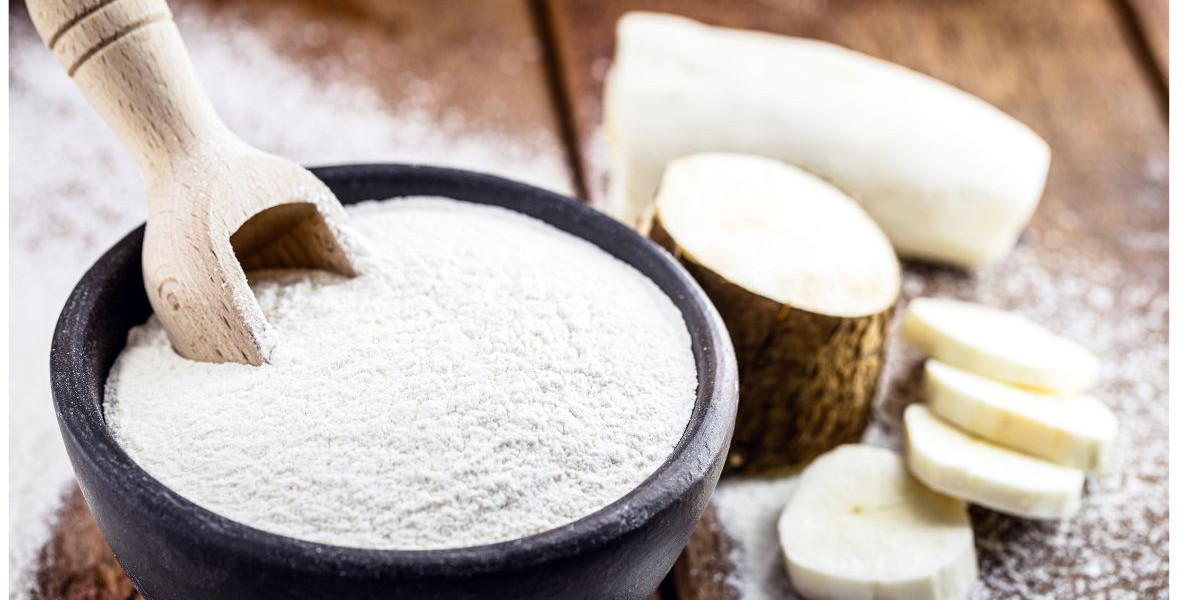Cassava starch is a versatile and valuable ingredient that is widely used in various industries, such as food and beverage, paper and pulp, textile, pharmaceutical, and biofuel. The global cassava starch market size stood at 6.9 million metric tons in 2020. The industry is expected to witness a moderate growth in the forecast period of 2024-2032, driven by the increasing demand for convenience foods, gluten-free products, and renewable materials.
However, the cassava starch market is also subject to various standards and regulations that affect its production, processing, trade, and consumption. These regulations aim to ensure the quality, safety, and sustainability of cassava starch and its derived products, as well as to protect the interests of consumers, producers, and traders. In this blog post, we will provide an overview of the regulatory landscape affecting the cassava starch market, including food safety standards, labeling requirements, and international trade regulations. We will also highlight some of the emerging trends and challenges that cassava starch stakeholders need to be aware of and prepare for.
Food Safety Standards
Food safety standards are the rules and guidelines that govern the production, processing, storage, distribution, and consumption of food and food ingredients, such as cassava starch. They aim to prevent foodborne illnesses, contamination, and adulteration, and to ensure the quality and consistency of food products. Food safety standards are set and enforced by various authorities, such as national governments, regional organizations, and international bodies.
Some of the most common and widely adopted food safety standards that apply to cassava starch and its derived products are:
- The Codex Alimentarius, which is a collection of international food standards, guidelines, and codes of practice developed by the Codex Alimentarius Commission, a joint body of the Food and Agriculture Organization (FAO) and the World Health Organization (WHO). The Codex Alimentarius covers aspects such as food hygiene, food additives, contaminants, labeling, and methods of analysis and sampling.
- The Hazard Analysis and Critical Control Point (HACCP) system, which is a preventive approach to food safety that identifies, evaluates, and controls the hazards that may arise during the production, processing, handling, and distribution of food and food ingredients. The HACCP system is based on seven principles: conducting a hazard analysis, identifying the critical control points, establishing the critical limits, monitoring the critical control points, taking corrective actions, verifying the effectiveness of the system, and keeping records.
- The International Organization for Standardization (ISO) standards, which are voluntary standards developed by the ISO, an independent, non-governmental organization that represents the national standards bodies of over 160 countries. The ISO standards provide specifications, guidelines, and best practices for various aspects of food and food ingredients, such as quality management, environmental management, food safety management, and traceability.
Cassava starch producers, processors, and traders need to comply with the food safety standards that are applicable in their target markets, as well as to obtain the necessary certifications and accreditations that demonstrate their compliance. This can help them to ensure the quality and safety of their products, to gain the trust and confidence of their customers, and to avoid the risks of rejection, recall, or legal action.
Labeling Requirements
Labeling requirements are the rules and guidelines that govern the information that must be provided on the labels of food and food ingredients, such as cassava starch. They aim to inform and protect the consumers, as well as to prevent misleading or deceptive claims. Labeling requirements are set and enforced by various authorities, such as national governments, regional organizations, and international bodies.
Some of the most common and widely adopted labeling requirements that apply to cassava starch and its derived products are:
- The Codex General Standard for the Labeling of Prepackaged Foods, which is a Codex Alimentarius standard that establishes the general principles and requirements for the labeling of prepackaged foods, such as the name of the food, the list of ingredients, the net quantity, the date of minimum durability, the storage and usage instructions, the name and address of the manufacturer or distributor, and the country of origin.
- The European Union (EU) Regulation on the Provision of Food Information to Consumers, which is a regulation that applies to all food and food ingredients sold in the EU, and that lays down the rules for the provision of food information to consumers, such as the mandatory and voluntary information, the presentation and format of the information, the nutrition declaration, the allergen labeling, and the origin labeling.
- The United States (US) Food and Drug Administration (FDA) Food Labeling Guide, which is a guide that provides information and guidance on the labeling of food and food ingredients sold in the US, such as the statement of identity, the net quantity of contents, the nutrition facts, the ingredient list, the name and place of business of the manufacturer or distributor, and the country of origin.
Cassava starch producers, processors, and traders need to comply with the labeling requirements that are applicable in their target markets, as well as to ensure that their labels are accurate, truthful, and not misleading. This can help them to communicate the characteristics and benefits of their products, to meet the expectations and preferences of their customers, and to avoid the risks of non-compliance, fines, or lawsuits.
International Trade Regulations
International trade regulations are the rules and guidelines that govern the import and export of goods and services, such as cassava starch. They aim to facilitate and regulate the international trade, as well as to protect the interests of the trading partners, the environment, and the public health. International trade regulations are set and enforced by various authorities, such as national governments, regional organizations, and international bodies.
Some of the most common and widely adopted international trade regulations that apply to cassava starch and its derived products are:
- The World Trade Organization (WTO) Agreement on the Application of Sanitary and Phytosanitary Measures (SPS Agreement), which is an agreement that sets out the basic rules for food safety and animal and plant health standards that affect the international trade. The SPS Agreement allows the WTO members to adopt their own standards, but also requires them to base their standards on scientific evidence, to harmonize their standards with the international standards, and to avoid the unnecessary or unjustified barriers to trade.
- The World Trade Organization (WTO) Agreement on Technical Barriers to Trade (TBT Agreement), which is an agreement that sets out the basic rules for technical regulations, standards, and conformity assessment procedures that affect the international trade. The TBT Agreement allows the WTO members to adopt their own regulations, standards, and procedures, but also requires them to ensure that they are not more trade-restrictive than necessary, that they are based on the legitimate objectives, and that they are transparent and non-discriminatory.
- The Regional Trade Agreements (RTAs), which are agreements that are signed by two or more countries or regions to establish preferential trade arrangements, such as free trade areas, customs unions, or common markets. The RTAs can cover various aspects of trade, such as tariffs, quotas, rules of origin, sanitary and phytosanitary measures, technical barriers to trade, and trade facilitation. Some of the examples of RTAs that affect the cassava starch market are the African Continental Free Trade Area (AfCFTA), the Association of Southeast Asian Nations (ASEAN) Free Trade Area (AFTA), and the Comprehensive and Progressive Agreement for Trans-Pacific Partnership (CPTPP).
Cassava starch producers, processors, and traders need to comply with the international trade regulations that are applicable in their target markets, as well as to obtain the necessary permits, licenses, and certificates that prove their compliance. This can help them to access and expand their markets, to benefit from the preferential trade arrangements, and to avoid the risks of trade disputes, sanctions, or penalties.
Emerging Trends and Challenges
The regulatory landscape affecting the cassava starch market is constantly evolving and changing, as the authorities and the stakeholders respond to the new developments and challenges in the industry. Some of the emerging trends and challenges that cassava starch stakeholders need to be aware of and prepare for are:
- The increasing demand for organic, natural, and sustainable products, which is driven by the growing consumer awareness and preference for the products that are produced and processed in an environmentally friendly and socially responsible manner. This can create new opportunities for the cassava starch producers, processors, and traders who can offer organic, natural, and sustainable products, but also new challenges for them to comply with the relevant standards and certifications, such as the EU Organic Regulation, the US National Organic Program, and the International Federation of Organic Agriculture Movements (IFOAM) standards.
- The rising concern for the food security and sovereignty, which is driven by the impact of the COVID-19 pandemic, the climate change, and the geopolitical tensions on the global food supply and demand. This can create new opportunities for the cassava starch producers, processors, and traders who can contribute to the food security and sovereignty of their countries and regions, but also new challenges for them to cope with the potential disruptions, uncertainties, and risks in the global market.
- The growing innovation and diversification in the cassava starch industry, which is driven by the advancement of the technology, the emergence of the new applications, and the competition from the other starch sources. This can create new opportunities for the cassava starch producers, processors, and traders who can offer innovative and diversified products, such as modified starches, resistant starches, and biodegradable plastics, but also new challenges for them to comply with the novel and complex regulations, standards, and procedures that may apply to these products.
The regulatory landscape affecting the cassava starch market is a dynamic and complex one, that requires the cassava starch stakeholders to be well-informed, well-prepared, and well-adapted. By understanding and complying with the current and emerging regulatory challenges and opportunities, the cassava starch stakeholders can enhance their competitiveness, profitability, and sustainability in the global market.















